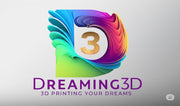In the landscape of modern investing, opportunities are abundant, yet navigating through the myriad of options requires a keen eye for innovation and a forward-thinking mindset. One such innovation that has been steadily gaining traction is 3D printing, a technology with the potential to revolutionize various industries and reshape our future. In this blog, we delve into the intriguing intersection of investing and 3D printing, uncovering the potential opportunities and challenges it presents.
Understanding 3D Printing
First, let's grasp the essence of 3D printing. Also known as additive manufacturing, 3D printing is a process of creating three-dimensional objects by depositing successive layers of material based on a digital model. Unlike traditional manufacturing methods, which often involve subtracting material from a solid block or molding it into shape, 3D printing builds objects layer by layer, offering unparalleled design freedom and customization.
The Evolution of 3D Printing
Initially conceived as a prototyping tool, 3D printing has evolved rapidly, expanding its applications across various sectors. Today, it is used in aerospace, automotive, healthcare, consumer goods, architecture, and even food industries, among others. From rapid prototyping and on-demand manufacturing to personalized medical implants and intricate architectural models, the versatility of 3D printing knows few bounds.
Investing in 3D Printing: Opportunities and Considerations
For investors eyeing the potential of 3D printing, several factors merit consideration:
-
Diversified Industry Exposure: While pure-play 3D printing companies exist, investors can also explore opportunities in industries that leverage 3D printing for innovation and efficiency gains. This includes companies involved in materials manufacturing, software development, 3D scanning, and end-user applications.
-
Technological Advancements: Keeping abreast of technological advancements within the 3D printing ecosystem is crucial. From new printing materials and techniques to breakthroughs in software algorithms and hardware capabilities, staying informed allows investors to identify emerging trends and opportunities.
-
Market Adoption and Regulation: The rate of market adoption and regulatory landscape surrounding 3D printing can significantly impact investment outcomes. Factors such as intellectual property rights, quality standards, and regulatory approvals for medical and aerospace applications can influence the growth trajectory of 3D printing companies.
-
Long-Term Vision: Investing in 3D printing requires a long-term perspective. While the technology holds immense promise, widespread adoption and scalability may take time. Patience and a belief in the transformative potential of 3D printing are essential for investors seeking sustainable returns.
Case Studies: Success Stories and Lessons Learned
Numerous success stories abound in the realm of 3D printing investing. From early backers of industry pioneers like 3D Systems and Stratasys to investors in specialized 3D printing software firms like Autodesk, the journey has been marked by innovation, resilience, and strategic foresight.
However, the landscape is not without its challenges. Companies operating in the 3D printing space face competition, technological hurdles, and market volatility. Investors must conduct thorough due diligence, assess risk factors, and diversify their portfolios accordingly.
Looking Ahead: The Future of Investing in 3D Printing
As we look ahead, the convergence of 3D printing with other disruptive technologies such as artificial intelligence, robotics, and blockchain holds immense promise. The emergence of 4D printing, capable of creating objects that can self-assemble or change shape in response to external stimuli, further expands the possibilities.
Investors who embrace the transformative potential of 3D printing and position themselves strategically stand to reap the rewards of this technological revolution. By staying informed, exercising patience, and maintaining a diversified portfolio, they can navigate the complex terrain of investing in 3D printing and contribute to shaping a future where imagination knows no bounds.
In conclusion, the intersection of investing and 3D printing represents a compelling frontier for those with a vision for the future. As we witness the continued evolution of this transformative technology, the opportunities for investors are limited only by the bounds of imagination.
